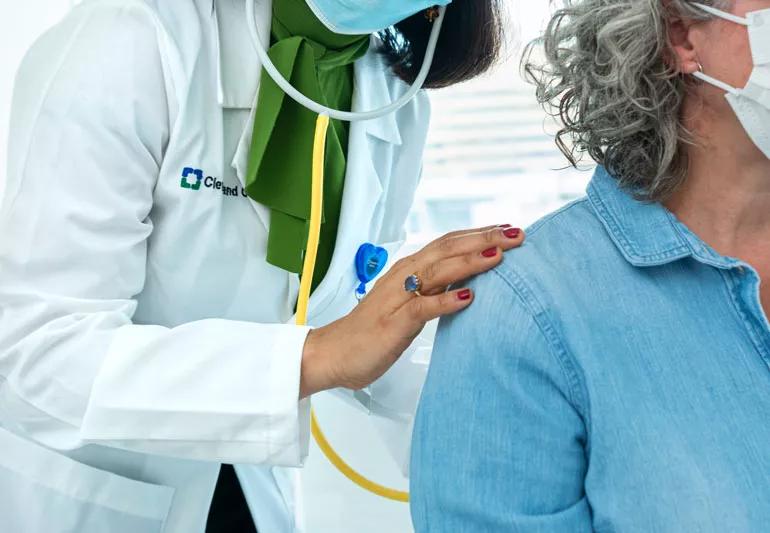They practice medicine similarly, but DOs have a focus on the mind, body, spirit connection

Medicine is a favorite topic of television shows. If you’re a fan of Meredith Grey, Gregory House or Doogie Howser, you know all these fictional characters are MDs.
Advertisement
Cleveland Clinic is a non-profit academic medical center. Advertising on our site helps support our mission. We do not endorse non-Cleveland Clinic products or services. Policy
But did you know there’s a type of healthcare provider called a DO? DOs aren’t typically the focus of TV shows, but they’re equally qualified to care for you and your family.
“As a primary care provider, I work alongside DOs in my practice,” says family medicine specialist Neha Vyas, MD. “We see similar patients and provide the same level of care.”
An MD is a Doctor of Medicine, while a DO is a Doctor of Osteopathic Medicine. The bottom line? They do the same job, have similar schooling, can prescribe medication and can practice all over the U.S.
“In general, DOs practice a more holistic, whole-person type of care,” explains Dr. Vyas. “MDs take a more allopathic, or illness-based, approach.”
Allopathic and osteopathic medicine differ in several ways:
But these philosophical differences don’t necessarily define the way DOs and MDs practice medicine. For example, DOs use all types of modern medical treatments, and MDs provide whole-person and preventive care.
Advertisement
The development of the MD and DO degrees follows the history of medical education in the U.S. The first medical schools, which opened in the mid-1700s, originally offered a Bachelor of Medicine, but quickly developed the Doctor of Medicine (MD) degree.
A physician named Andrew Taylor Still, MD, established the first DO training program in 1892. Dr. Still’s philosophy about medicine changed after serving in the Civil War and experiencing the deaths of three of his children from spinal meningitis. He believed traditional medicine was ineffective, so over many years, he developed the concept of osteopathic medicine.
As of the end of 2022, there were 154 allopathic medical schools and 38 schools of osteopathic medicine in the U.S.
Admission requirements for MD and DO programs are similar. Both rely heavily on undergraduate grade point averages (GPA) and Medical College Admission Test (MCAT) scores.
“The standards for getting into the two programs are a bit different,” notes Dr. Vyas. “MD programs typically require slightly higher average GPAs and MCAT scores than DO programs — but not by much.”
Both MDs and DOs follow a four-year curriculum that involves:
“The main difference between MD and DO programs is that DOs receive 200 hours of training in osteopathic manipulative medicine,” says Dr. Vyas. “This training is in addition to their regular classes.”
A key concept in osteopathic medicine is the connection between your body’s systems. An issue in one part of your body can affect other areas.
Osteopathic manipulative medicine, or osteopathic manipulative treatment (OMT), involves manipulating (touching or moving) your muscles, bones and joints. Manipulations can include gentle pressure and stretching or more forceful maneuvers.
These techniques can improve alignment, balance and circulation. They allow your whole body to function better and activate your body’s self-healing mechanisms.
OMT can help improve musculoskeletal pain and a wide range of health conditions, like:
DOs use OMT to diagnose, treat and prevent disease in people of all ages.
After medical school, students must pass an exam. MDs take an exam called the U.S. Medical Licensing Exam (USMLE). DOs take the Comprehensive Osteopathic Medical Licensing Exam (COMLEX) and can also take the USMLE.
Advertisement
The USMLE and COMLEX both include three levels:
After medical school, MDs and DOs complete a three-year residency program. “A residency is an apprenticeship in a specialty area,” Dr. Vyas explains. “The residents care for patients independently but under the supervision of other physicians.”
Residency is a grueling experience that typically involves 80-hour work weeks. During this time, MDs and DOs work side by side, rotating through inpatient and outpatient settings. The first year of residency is called the internship and includes rotations in multiple specialties. Second- and third-year residents focus more on their chosen specialty.
Some MDs and DOs choose to do a fellowship after their residency, which provides more in-depth subspecialty training.
Both MDs and DOs can choose any specialty area of medicine, though DOs are more likely to select primary care specialties. The American Osteopathic Association reports that nearly 60% of DOs practice in family medicine, internal medicine and pediatrics compared with 28% of MDs.
Advertisement
Other popular specialties for DOs include:
As of 2019, of the active medical providers in the U.S.:
But the number of DOs is rising. In the past decade, the number of DOs and osteopathic medical students has increased by 81%.
MDs and DOs are equally trained and follow the most recent guidelines for disease prevention and treatment. Neither is better, but you may have a preference based on your view of medicine.
And whether a healthcare provider is a good fit for you depends on many factors, including their personality, communication skills and treatment approach. By researching your options and asking questions, you can find a provider who meets all your needs.
Advertisement
Learn more about our editorial process.
Advertisement

They’re fun to watch, but medical TV shows are often more hype than reality — and you shouldn’t rely on them for factual medical information

The best way to figure out which kind you need is to first speak with your primary care provider

These red, raised bites often show up in a zigzag pattern on areas of your skin that come into contact with bedding

Some things you find in your house have antifungal properties — but that doesn’t mean they’ll clear your toenail fungus

Home remedies are unlikely to cure your contagious foot fungus — and they might even make it worse

Earlobe piercings heal quicker and are less painful than cartilage piercings — proper cleaning and care are important

Having a PCP means knowing where to go for a range of concerns — that’s a good thing for your lifelong health

Over-the-counter pills, powders, extracts and tinctures can interact with other medications and cause unexpected side effects

If you’re feeling short of breath, sleep can be tough — propping yourself up or sleeping on your side may help

If you fear the unknown or find yourself needing reassurance often, you may identify with this attachment style

If you’re looking to boost your gut health, it’s better to get fiber from whole foods